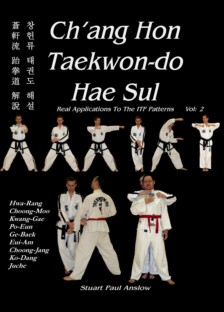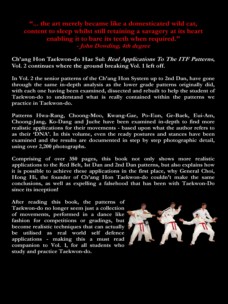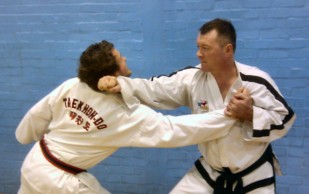Foreword - John Dowding, 4th degree |
Foreword - John Dowding, 4th degree It is with great pleasure that I write this foreword for this the second volume of Ch’ang Hon Taekwon-Do Hae Sul. I became aware of Stuart Anslow some years ago as a name which cropped up on a few Taekwon-Do forums I frequented. I quickly came to respect his knowledge and open minded viewpoint, which at a particularly turbulent time in the world of Taekwon-Do was a breath of fresh air. I purchased the first volume of Ch’ang Hon Taekwon-Do Hae Sul and with my interest in practical applications was impressed enough to actually put my thoughts into a book review. With the release of Mr Anslow’s Encyclopaedia of Taekwon-Do Patterns I again felt that an important gap in the library shelf had been filled. I first met Mr Anslow in March of 2011 at the PUMA World Championships where he was competing with a small but impressive group of his students. After this we became friends and I was pleased to be involved with the secondary proof reading for the Encyclopaedia of Taekwon-Do Patterns (released as a 2nd edition). Following the release of the second edition I continued in the role of proof reader for this the second volume of Ch’ang Hon Taekwon-Do Hae Sul which brings us to where we are today. This volume continues the journey of Mr Anslow into the heart and essence of traditional Taekwon-Do forms required by the syllabus developed by General Choi Hong Hi and practised by millions worldwide. For too long this important aspect of the Art of Taekwon-Do has been ignored, neglected, |
Ch'ang Hon Taekwon-do Hae Sul Real Applications To The ITF Patterns Vol: 2 The new book by Stuart Anslow |
Recommended Reading |
Recommended Reading |



NEW HARDBACK EDITION |


FREE postage from Amazon |
FREE postage from Amazon |
UK |
USA |
Germany |
France |
Please Select Your Country To Order From You can also purchase via: Amazon Japan or Amazon China (coming soon) |
Italy |
Spain |
Canada |
and even denied by some, to the detriment of the martial system it was originally
intended to be. Taekwon-Do was forged as a killing art in the grim and bloody reality of the battlefields of Korea and Vietnam. There were no points to be won and no trophies to win, just one goal, to win in order to survive. Form was not as important as functionality when it came to combat, if it was effective it remained and if it was ineffective it was discarded as it had no place on the battlefield. In peacetime as Taekwon-Do spread and flourished throughout the world gradually the battlefields were forgotten and the emphasis shifted, techniques were refined and competition replaced hand to hand combat. The practitioners of the art changed from battle hardened soldiers whose very life depended on their mastery of Taekwon-Do to the civilian practitioner who looked for something very different in a martial art. However the art itself never changed it merely became like a domesticated wild cat, content to sleep whilst still retaining a savagery at its heart enabling it to bare its teeth when required. The roots of the Chang Hon system lie in the Katas of Karate, and these Katas were originally not part of a fighting system. They were a complete fighting system on their own. It was not unusual for the early Masters to only learn one or maybe two Kata and for the knowledge that was locked within these Kata to be enough to be extremely proficient in the art of self-defence for anyone with the benefit of the key of knowledge to unlock the secrets within. General Choi through his Karate training had knowledge of these systems but did he ever possess the key to unlock them or was the key kept from him because of his Korean identity? Or was it the case that the Sensei’s who taught General Choi did not possess the key themselves, as the secrets had been retained by the Okinawan Masters and were simply not part of the simplified Karate systems developed and introduced to the schools in Okinawa and Japan? We shall never know. But we do know that General Choi borrowed from these systems and used his knowledge of Karate as the foundation for his creation of the Ch’ang Hon system of Taekwon-Do. We know this because we can compare our Tuls with the Kata of the various Karate styles and see for ourselves the similarities and parallels that clearly show where our art originated. It’s possible that because these secrets were retained or unknown to the Karate Sensei’s who taught General Choi and other early Korean pioneers they were simply not developed as part of the traditional Ch’ang Hon syllabus. With the first and now this second volume of Ch’ang Hon Taekwon-Do Hae Sul Mr Anslow has grasped the bull by the horns and finally addressed the most neglected aspect of our beloved art. I believe that Patterns are the heart of our system and now our heart beats stronger and with renewed vigour thanks to the ideas contained within this book and the research conducted by Mr Anslow. You may not agree with everything contained within the pages of this book, but what you will find on these pages will make you revisit and re-evaluate a key element of your everyday Ch’ang Hon Patterns practise. Mr Anslow does not state that these applications are handed down from the past through thousands of years of history, nor does he claim that the applications he presents are what were intended when the Patterns were developed by General Choi and the early pioneers. He presents his research and his findings for us to consider, to use, or to dismiss as we the practitioner see fit. For anyone familiar with the Patterns contained within this book there is one thing that is guaranteed when you study the applications within. It is guaranteed that you will think about the moves contained within your Patterns in a new light and with a different perspective and whether or not you like that light or the perspective revealed; thinking about it can only be a good thing. So enjoy this book as much as I have, think about the applications presented within, try them out, use them as inspiration to develop your own if you wish, experiment with them, discard any you don’t agree with, but always keep in mind they are not wrong and they are not right, they simply are what they are. Possibilities that will enhance your training and understanding of the patterns of Ch’ang Hon Taekwon-Do John Dowding, IV |
